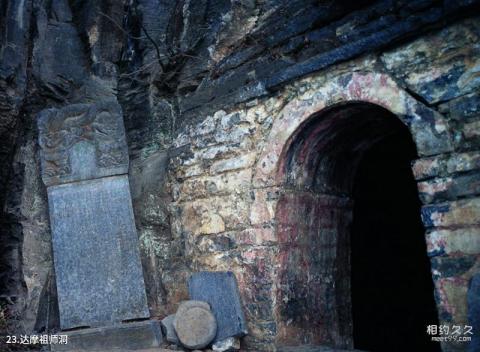
Introduction to Bodhidharma Cave: Bodhidharma Cave is located on the cliff of Bodhidharma Mountain. This cave was originally a natural rock cave. After Tibetan Buddhism was introduced to Diqing, folklore said that Bodhidharma faced the wall for ten years in this cave. He became a Buddha when he was young, leaving an image of his face on the cave wall and a sacred mark of his feet forming a depression. From this, the cave got its name from Patriarch Bodhidharma Cave. Around the early Qing Dynasty, people who believed in Buddhism built several Zen rooms along the cliff by stacking logs along the cliff. Bodhidharma Cave became a holy place for Buddhists to worship and a place for practice. This kind of building built on the cliff is breathtaking. From a distance, it looks like a kind of decoration hanging on the cliff, which is a wonderful work of art. With Bodhidharma's Patriarch's Cave and the monk's residence in the Sutra Hall outside the cave as the center, Laiyuan Temple and Bodhidharma Temple at the foot of the mountain are just to the left and right of it, forming a three-legged tripod, leaning on each other.
Pilgrims often take part in mountain trekking activities. The route starts from the entrance of the cave and goes around the top of the mountain, a distance of about 3 kilometers. Because mountain climbing has been around for a long time, trails have been formed. It is said that the first day of the fourth lunar month every year is the day when Bodhidharma became a Buddha. At that time, pilgrims from Shangri-La, Deqin, Weixi and Lijiang gather here, traveling long distances and even sleeping in the open air to complete the mountain trekking activity.
In the Sutra Hall of the Patriarch Cave, there are statues of Sakyamuni, Padmasambhava, Tsongkhapa, and statues of the founders of the Zhigong Kagyu Sect and the Karma Kagyu Sect. It also houses the "Dun" of the Patriarch Bodhidharma. The holy relics that are "enough to form a puddle" and the spiritual pagoda with relics of Patriarch Bodhidharma and the spiritual pagodas with relics of Patriarch Bodhidharma's disciples.
Traffic information: Exit Tacheng, Weixi County and go east for 15 kilometers. You can walk or take a taxi.
Scenic spot location: Weixi Lisu Autonomous County, Diqing Tibetan Autonomous Prefecture, Yunnan Province.
